Roman Baths |
|
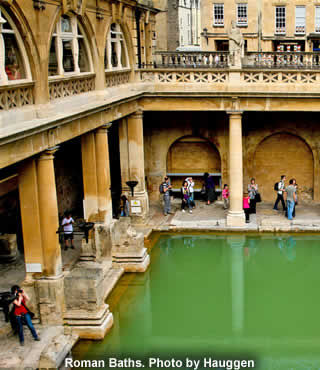 |
|||
Bath's namesake, and its greatest heirloom |
||
Listen to this article |
||
The Roman Baths are such an important part of this city's history that they gave the place its name. The 2000-year-old structure is one of the most popular tourist attractions in the south-west, with over a million visitors every year. |
||
The bathhouse's existence is all thanks to the hot spring water that bubbles up from deep underground. It begins its journey upward at a depth of several kilometres, where it is warmed by the earth's core. The pressure forces the liquid towards the surface, where it arrives at a balmy 46 degrees centigrade. |
||
The spring was supposedly first discovered in the 9th century BC, but it was the Romans, nearly a millennium later, who made best use of it. Construction of their magnificent bathhouse was begun in the 1st century, and improvements were still being made 300 years later. A visit here became one of the great pleasures of early English life. |
||
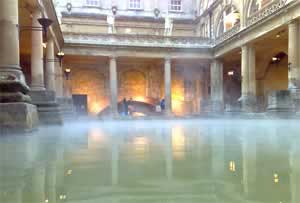 The hot water of the baths Photo markhillary |
||
After the Romans left in the 5th century, the building fell into disrepair and became largely forgotten about. Silting and flooding even caused it to disappear from view. Remarkably, it took until 1880 for a sewer engineer to rediscover it by chance, while investigating a leak! The Victorians, realising its significance, reclaimed, restored and reused it. An extensive construction project transformed the bathhouse once again into the most popular and fashionable place in the city. It's easy to tell which parts of the complex are newer, and which are older. Simply, everything built at street level is a relatively recent addition. All the ancient Roman structures are lower than that, sunk into the ground. |
||
The key part of this original building is the Great Bath. This huge, rectangular pool may be below street level but, as there is no ceiling, it still looks up at the sky. The room did have a roof when it was originally built. The ceiling would have been around 40 metres high, making this the largest structure that most Romans would have ever entered. |
||
The Great Bath's roof may have since disappeared, but it's still surrounded by the original stone pillars. These are one of the building's iconic features, as seen in countless photographs. You can view them from street level if you like, by walking along the Victorian terrace. It's lined with the statues of Roman heroes, gazing sternly down at the water. |
||
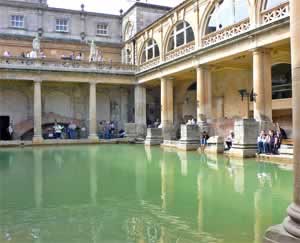 The Great Bath Photo heatheronhertravels |
||
While this main room is the most famous part of the complex, it makes up less than a quarter of the entire site. There are plenty of other rooms to explore. The Romans often divided their time between baths of different temperatures, so you'll see several other pools. These range from the scalding hot waters of the caldarium, to the paralysing cold contents of the frigidarium. |
||
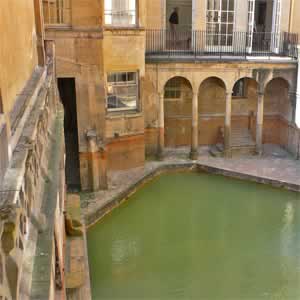 Exploring the Roman Baths Photo heatheronhertravels |
||
Some of these are still filled with water, but unfortunately you can't take a dip. This is because the liquid still passes through the original lead pipes, which have begun to decay. If you were to swallow any of it, you'd certainly become very seriously ill! Thankfully, there's a much more modern spa nearby, giving you a chance to experience the thermal waters without needing a hospital visit afterwards. |
||
The complex also contains a museum, displaying all sorts of Roman artefacts. The most impressive of these are the statues and carvings, mostly depicting ancient gods and deities. |
||
Next door to the bathhouse is a late 18th century structure called the Grand Pump Room. Back then, it was a social hub for the nobles and upper classes. In the last 200 years it has barely changed, and many of its decorations and furnishings are exactly the same. Nowadays the place is an upmarket restaurant, with elegant tables set out under glittering chandeliers. They have a fountain that's connected to the same spring as the baths, so diners can take a glass of the warm, mineral-filled water to drink. |
||
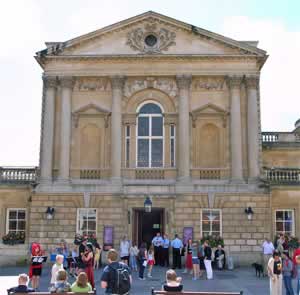 Grand Pump Room Photo stevecadman |
||
The city of Bath is a World Heritage site. It's crammed full of impressive architecture, which all contributed to this achievement. However, the Roman bathhouse is surely the most important building of them all. Without it, the city probably wouldn't be known as the incredible historic place that it is. |
||
|
||
The Roman Baths are open daily, 9.30am to 5pm (later in summer). Entry costs around £12 for adults, £7.50 child. Tel: 01225 477785 |
||
|
Pocket Britain is optimised for use on a smartphone or tablet with internet access. All content is subject to copyright. All reasonable methods have been used to ensure information supplied is accurate at the time of publication. However, it is advisable to check information before relying on it. Privacy Policy |